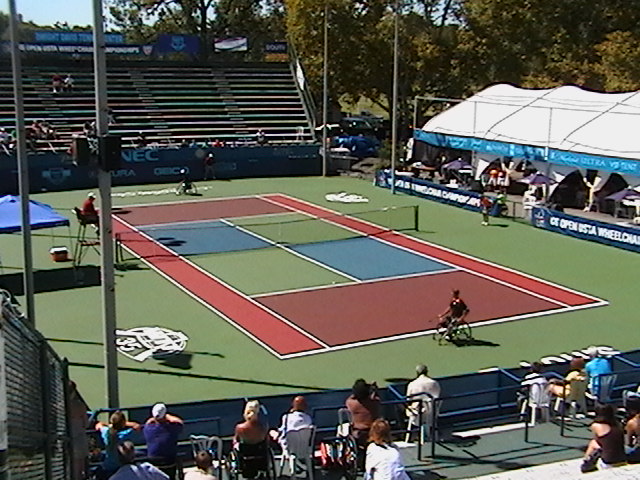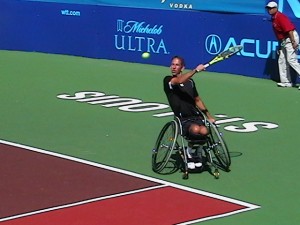Tennis via wheelchair
Tennis is a difficult sport to play. The court is large for one person, so you need to be able to  move quickly and in coordinated fashion. It also helps to have a powerful tennis stroke, to allow you to drive the ball deep into the opponent's court.
I saw all of these qualities in the top contenders playing in the USTA (United States Tennis Association) Wheelchair Tennis Championship in St. Louis. I took a few minutes of video of the Men's Singles final match between Shingo Kunieda of Japan (the number one seed, who won the match) and Robin Ammerlaan of the Netherlands. Kunieda probably didn't surprise many by taking the top spot, given that he has now won more than one hundred consecutive matches. Just prior to the Men's final, Ester Vergeer of the Netherlands beat Jiske Griffioen, also of the Netherlands, for the Women's Singles title. Vergeer has won more than 120 consecutive matches. Here are the final standings for the St. Louis Tournament.
It was stunning to watch the speed and coordination of these players. It was especially impressive to watch how they anticipate. I took some still photos of the Kunieda/Ammerlaan match and posted them in a gallery to this post (if you don't see it here, just click on the title to the post). For additional photos, including photos of the women finalists, go here. I also took a few minutes of video--this video mostly demonstrated the lack of precision of my cheap DV camcorder (it's sometimes hard to see the ball), but it will also give you a good idea of the power of the ground strokes these players can muster, along with illustrations of their precision and speed. [Note: the first 20 seconds are actually the end of the pregame warmups].
Again, these are excellent athletes. I hate to sound naive, but before this weekend, I never knew that people using wheelchairs could play competitive tennis. I've long known that people using wheelchairs could engage in all kinds of vigorous sports, but I assumed that the size of the court couldn't be tamed in a wheelchair. Well, one adjustment to the rules does the trick. In wheelchair tennis, the ball is in play for two bounces (rather than one bounce for the standard game).
On Friday, my wife and I watched parts of several matches between some players who had their racquets wrapped onto their arms. I inquired and was told that these are the "Quad" players, men and women who not only have physical deficits with their legs, but also with their arms (see the rules here). One of the "Quad" players had no ability to throw the ball up with his non-racquet hand. Instead, he "threw" the ball into the air by grabbing it on the ground with his racquet and his foot and flicking it up, then smashing it with an underhand serve loaded with topspin.
move quickly and in coordinated fashion. It also helps to have a powerful tennis stroke, to allow you to drive the ball deep into the opponent's court.
I saw all of these qualities in the top contenders playing in the USTA (United States Tennis Association) Wheelchair Tennis Championship in St. Louis. I took a few minutes of video of the Men's Singles final match between Shingo Kunieda of Japan (the number one seed, who won the match) and Robin Ammerlaan of the Netherlands. Kunieda probably didn't surprise many by taking the top spot, given that he has now won more than one hundred consecutive matches. Just prior to the Men's final, Ester Vergeer of the Netherlands beat Jiske Griffioen, also of the Netherlands, for the Women's Singles title. Vergeer has won more than 120 consecutive matches. Here are the final standings for the St. Louis Tournament.
It was stunning to watch the speed and coordination of these players. It was especially impressive to watch how they anticipate. I took some still photos of the Kunieda/Ammerlaan match and posted them in a gallery to this post (if you don't see it here, just click on the title to the post). For additional photos, including photos of the women finalists, go here. I also took a few minutes of video--this video mostly demonstrated the lack of precision of my cheap DV camcorder (it's sometimes hard to see the ball), but it will also give you a good idea of the power of the ground strokes these players can muster, along with illustrations of their precision and speed. [Note: the first 20 seconds are actually the end of the pregame warmups].
Again, these are excellent athletes. I hate to sound naive, but before this weekend, I never knew that people using wheelchairs could play competitive tennis. I've long known that people using wheelchairs could engage in all kinds of vigorous sports, but I assumed that the size of the court couldn't be tamed in a wheelchair. Well, one adjustment to the rules does the trick. In wheelchair tennis, the ball is in play for two bounces (rather than one bounce for the standard game).
On Friday, my wife and I watched parts of several matches between some players who had their racquets wrapped onto their arms. I inquired and was told that these are the "Quad" players, men and women who not only have physical deficits with their legs, but also with their arms (see the rules here). One of the "Quad" players had no ability to throw the ball up with his non-racquet hand. Instead, he "threw" the ball into the air by grabbing it on the ground with his racquet and his foot and flicking it up, then smashing it with an underhand serve loaded with topspin.
 As we watched the finals yesterday, I couldn't help but think that I was watching great athletes do extraordinary things, all to a relative smattering of clapping by the crowd of perhaps 500, many of whom were players and their families and friends.
If you have an opportunity to see a USTA match someday, whether in St. Louis or elsewhere, I'd highly recommend it.
As we watched the finals yesterday, I couldn't help but think that I was watching great athletes do extraordinary things, all to a relative smattering of clapping by the crowd of perhaps 500, many of whom were players and their families and friends.
If you have an opportunity to see a USTA match someday, whether in St. Louis or elsewhere, I'd highly recommend it.
